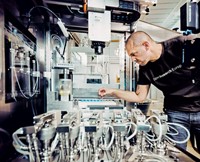Advertisement
Grab your lab coat. Let's get started
Welcome!
Welcome!
Create an account below to get 6 C&EN articles per month, receive newsletters and more - all free.
It seems this is your first time logging in online. Please enter the following information to continue.
As an ACS member you automatically get access to this site. All we need is few more details to create your reading experience.
Not you? Sign in with a different account.
Not you? Sign in with a different account.
ERROR 1
ERROR 1
ERROR 2
ERROR 2
ERROR 2
ERROR 2
ERROR 2
Password and Confirm password must match.
If you have an ACS member number, please enter it here so we can link this account to your membership. (optional)
ERROR 2
ACS values your privacy. By submitting your information, you are gaining access to C&EN and subscribing to our weekly newsletter. We use the information you provide to make your reading experience better, and we will never sell your data to third party members.
Energy Storage
Deals seek to advance AI in materials discovery
Microsoft and an Alphabet spin-off find partners to enhance existing computational skills
by Michael McCoy
January 11, 2024

Two new agreements underscore the inroads that artificial intelligence and other advanced computing techniques are making in the discovery of advanced materials for batteries and other clean technology applications.
Microsoft and the US Department of Energy’s Pacific Northwest National Laboratory (PNNL) are launching a 3-year effort to speed up scientific discovery by combining high-performance computing (HPC) and artificial intelligence. And SandboxAQ, a spin-off from Alphabet, has acquired the quantum chemistry simulation firm Good Chemistry for an undisclosed sum.
The collaboration between Microsoft and PNNL draws on Azure Quantum Elements, a discovery platform that Microsoft launched last June for chemistry and materials science researchers. Microsoft says the tool can speed up certain chemistry simulations by 500,000 times, allowing scientists to search for tens of millions of materials at once.
In a test of the tool, Microsoft researchers decided to search for a cheaper solid-state battery electrolyte by starting with 32.6 million candidate materials. They ran the candidates through AI models to narrow the pool to about 500,000 stable molecules. Another AI round screened these materials for functional properties like redox potential and bandgap, taking the list down to 800.
Only then did Microsoft researchers start using HPC, which is more accurate than AI but requires much more computing power. Using HPC in tandem with AI, they considered practical features such as novelty, mechanics, and element availability to take the list to 150 and then 18 candidates. PNNL researchers used their expertise to help Microsoft narrow the pool further to 5 candidates. The PNNL team then synthesized a final compound.
Nathan Baker, a product leader with Azure Quantum Elements, says combining HPC with AI allowed his team to complete in 80 h what could have taken decades with computing alone. HPC methods can typically screen about 1,000 candidates in 80 h, he says.
The synthesized electrolyte is now in a battery that PNNL tested at both room and high temperature. Because some lithium was replaced with sodium, the electrolyte contains about 70% less lithium than electrolytes in existing lithium-ion batteries, Microsoft says.
SandboxAQ was created in 2022 from molecular simulation and other assets of Alphabet, the company that owns Google. By acquiring Good Chemistry, itself a 2021 spin-off from 1QB Information Technologies (1QBit), SandboxAQ says it will add computational chemistry and AI simulation capabilities for drug discovery and materials design.
In September, SandboxAQ announced an agreement with the battery material developer Novonix aimed at predicting the life span of lithium-ion batteries using SandboxAQ’s chemical simulation software and Novonix’s battery cell prototyping and testing capabilities.
Other companies using a combination of computing and experimentation to improve battery materials include Mitra Chem and Wildcat Discovery Technologies.
In a press release, Nadia Carlsten, SandboxAQ’s vice president of product, says Good Chemistry’s software and partnerships will enhance SandboxAQ’s existing efforts in advanced simulation and AI. “Combining our capabilities will give SandboxAQ an advanced and scalable computing platform for highly accurate chemical simulation on a scale that makes impactful use cases such as new drug and material synthesis possible,” she says.



Join the conversation
Contact the reporter
Submit a Letter to the Editor for publication
Engage with us on Twitter